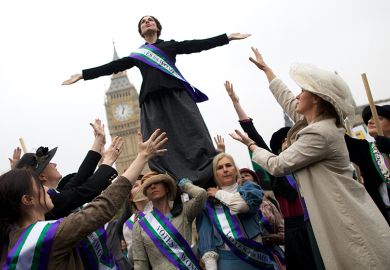In Margaret Cavendish’s 17th-century play Bell in Campo, the heroine Lady Victoria proclaims that women “shall eat when they will, and of what they will, and as much as they will, and as often as they will”. Cavendish is famous for thinking differently from her contemporaries, but she can rarely have been further off-piste than this. Sasha Garwood’s useful and readable book shows that several real-life counterparts of Lady Victoria were more likely to refuse food than to eat it, and to do so as a means of exerting control in difficult situations.
In the first part of the book, Garwood sets out a number of contexts for understanding early modern noblewomen’s refusal of food, including the importance of fast and fish days; contemporary conceptions and constructions of the female body; and the depiction of starving women in the theatre. She also reminds us that food refusal by early modern noblewomen cannot simply be seen as a form of anorexia nervosa (not identified as a condition until the 1870s), and that food refusal takes on a different meaning in a historical period when the non-elite might suffer famine. For women who were not already famous, starving could be a way to achieve celebrity, resulting in a stream of visitors who might even include royalty; for noblewomen, whose bodies were “crucial political entities”, it was a weapon.
This was particularly so for women close to the throne, which was the case for all five of the women considered in the “case studies” that make up the second half of the book. I’ll mention here my only beef with Garwood’s perceptive and elegant study: the title is not only cumbersome but not really accurate, because all five of her subjects – Catherine of Aragon and her daughter Mary Tudor, Elizabeth I, Lady Katherine Grey and Lady Arbella Stuart – are not so much noble as royal. That was a big part of their problems because all of them, in different ways and at different points in their lives, had to work hard to cling on to their royal status, and all manipulated their consumption of food as a way of doing so.
Catherine of Aragon, widowed, demoted and marginalised, went on hunger strikes. (Garwood is particularly interesting on how this tactic was authorised by the devotional fasting practised by Catherine’s mother, Isabel la Catolica.) Mary Tudor, declared a bastard and informed that her favoured infant half-sister Elizabeth needed her dinner at 11am, countered with her doctor’s advice that she needed her dinner at 9am, and was not going to be fobbed off with “superfluous breakfasts” (the difference being that breakfast was meatless). Later, Elizabeth herself performed food refusal as part of her image as a chaste, disciplined queen unhindered by the body of a weak and feeble woman. Katherine Grey and her granddaughter-in-law Arbella Stuart, both less canny and less securely royal than the Tudor princesses or Catherine of Aragon, simply stopped eating, gaining nothing but the moral high ground and ultimately starving to death. In fairy tales, real princesses can feel peas beneath their mattresses; Tudor queens refused food, but without fasting so much that it killed them.
Lisa Hopkins is professor of English at Sheffield Hallam University.
Early Modern English Noblewomen and Self-Starvation: The Skull Beneath the Skin
By Sasha Garwood
Routledge, 264pp, £120.00
ISBN 9781138280441
Published 21 August 2019
POSTSCRIPT:
Print headline: Princess and the pea-sized portion
Register to continue
Why register?
- Registration is free and only takes a moment
- Once registered, you can read 3 articles a month
- Sign up for our newsletter
Subscribe
Or subscribe for unlimited access to:
- Unlimited access to news, views, insights & reviews
- Digital editions
- Digital access to THE’s university and college rankings analysis
Already registered or a current subscriber?








